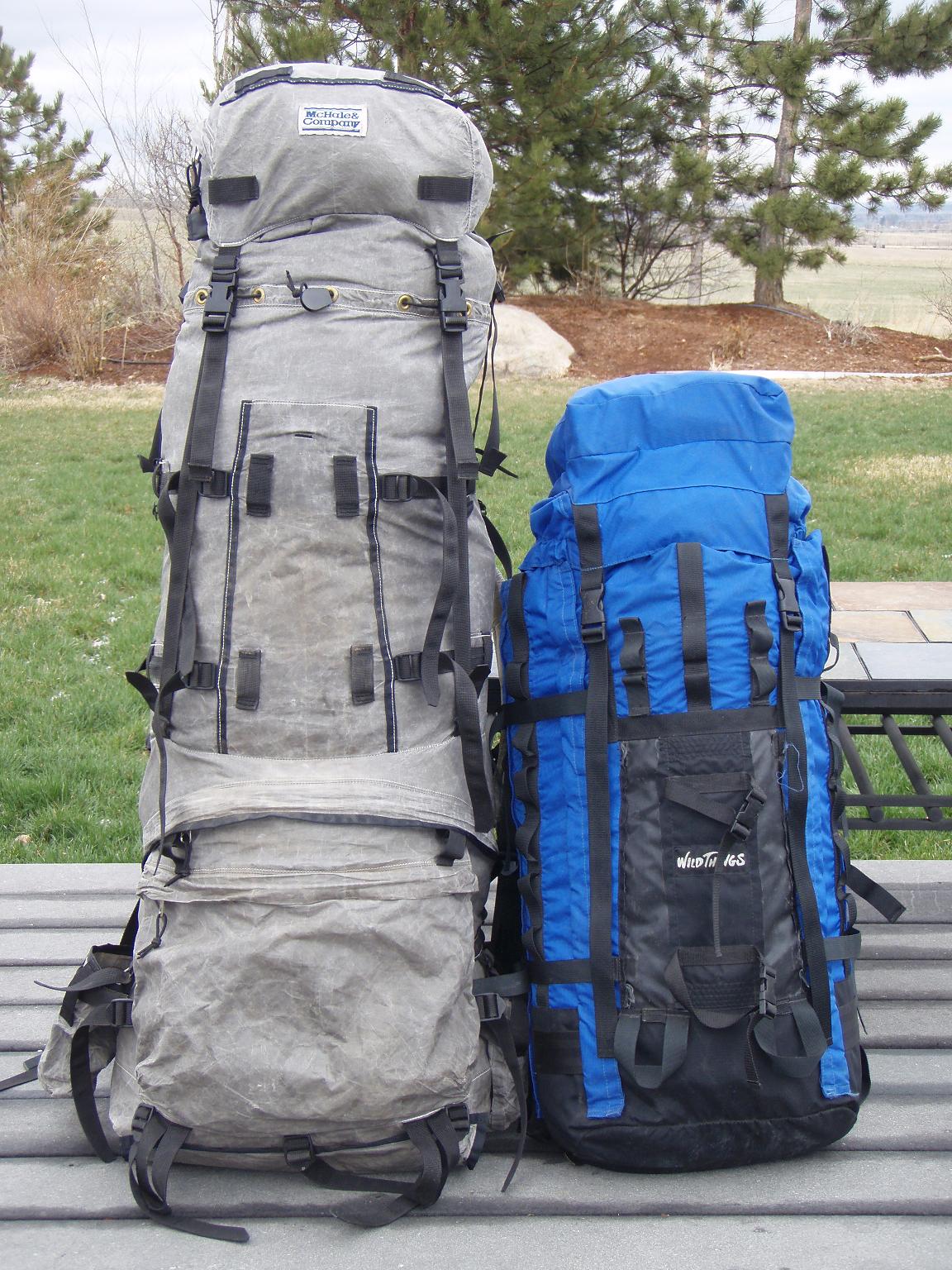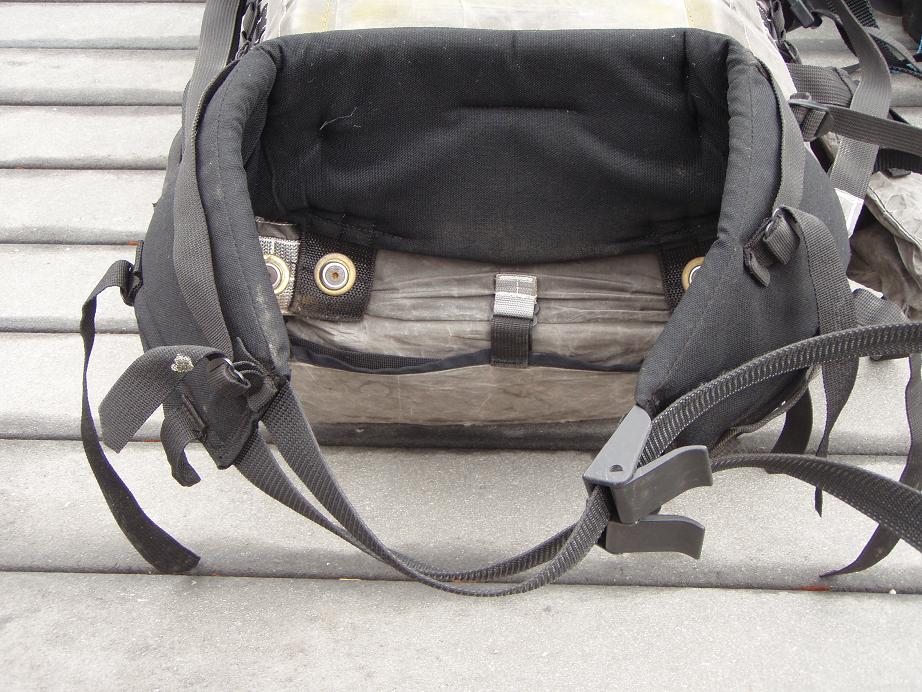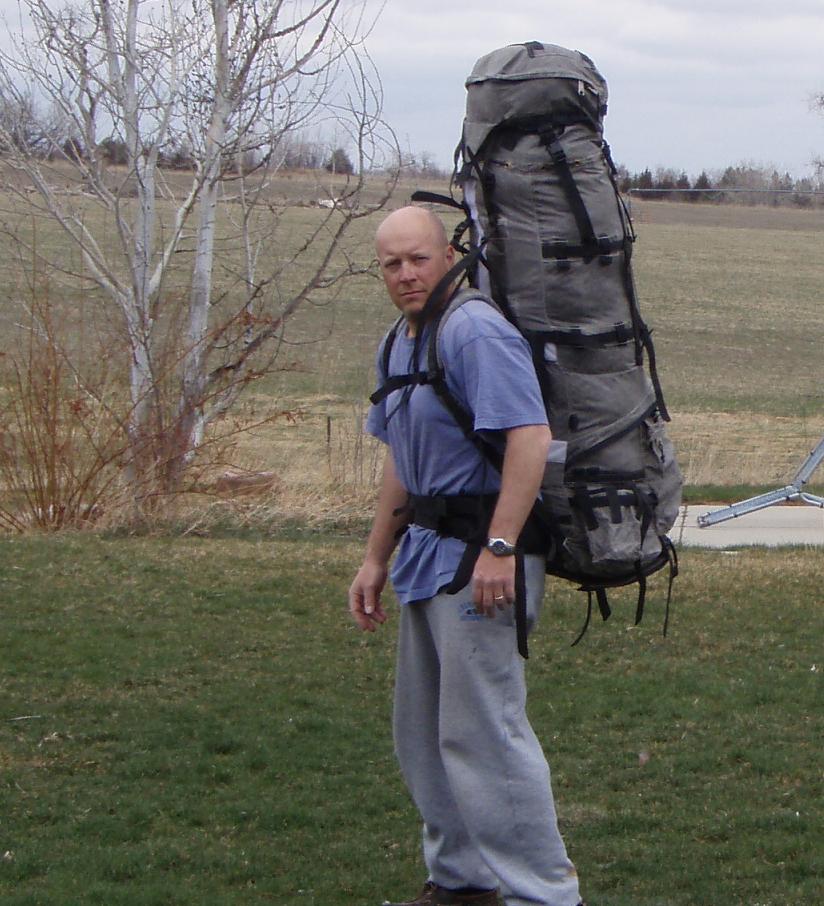|

|
| McHale Inex Alpineer Towering over the 5500 cubic inch Andinista |
The Godzilla of Loadmonsters
McHale Super Inex Alpineer (spectra fabric)
(7 pounds, 14 ounces)
I was a long-time Dana Designs user. I carried a Dana Arc Flex Astralplane
for many years on many long trips. Although overall, I really liked the Astralplane, I found it somewhat lacking for
carrying REALLY heavy loads (upwards of 75 pounds). After a great deal of research, and testing out packs by Gregory and Osprey
(which I didn't like as well as the Dana Astralplane), I bought a McHale Super INEX (McHale's biggest) in spectra fabric.
This was in 1995. After over a decade of heavy and many hundreds of miles with this pack, here are my thoughts
on the McHale Super INEX.

|
| The wide waistbelt and dual buckles are a McHale signature feature |
Waistbelt
The McHale pack has a super wide waistbelt, so wide that you need two buckles
to fasten it properly. McHale's waistbelt is definitely more comfortable than my old Dana Designs Astralplane, or any other
pack I have carried. Even with a big, heavy load of more than 90 pounds, the McHale waistbelt is so wide that the weight gets
distributed very evenly all the way around your hips. There are no hot spots or sagging, and the waistbelt on the
McHale can be left relatively loose and still support the load and not ride down on your butt. Because it is not attached
directly to the bottom of the pack, the McHale waistbelt also hinges as you walk, and the pack doesn't sway or bounce up and
down when you walk, because it isn't locked into your hip movement. Other big packs I've carried tend to bounce
and sway when walking fast or taking big steps, particularly when going downhill.
After long days hiking with other packs carrying heavy loads, my hips would
get sore under heavy loads. This does not happen with the McHale.
Shoulder Straps and Stabilizer (load lifter) Straps
The shoulder straps are not contoured as are some other packs on the market.
The Inex's straps are comfortable as long as I have the sternum strap buckled, but when it is unbuckled, they tend to interfere
with my arm swing a bit. This isn't too big of a problem, because I usually keep the sternum strap buckled.
The unique feature of the Inex's shoulder straps, however is that McHale has has
separated the stabilizer straps from the shoulder strap tightening straps, so you can adjust the tension of the shoulder straps
independently of the tension on the stabilizer straps which pull the pack into your back. It takes a while to get used to
this feature, but it is a big improvement and is not only more convenient, but also allows you to maintain a snug wrap of
your shoulder straps over your shoulders, while really cranking on the stabilizer straps, improving lateral stability.
With traditional packs, cranking on the stabilizer straps lifts the shoulder
straps off your shoulders, decreasing pack stability. You can compensate for this somewhat by re-adjusting your shoulder straps,
but I the McHale system provides a perfect fit with no fiddling. This feature sounds relatively insignificant, but it
does contribute to long term comfort and stability, two issues which become increasingly important, the larger the load you
are carrying.
Pack Bag Features
The McHale Super INEX is a HUGE pack. I don't really know how many cubic inches
it holds, but it's got to be well over 9000. The McHale is also a very tall pack when fully packed with the extension
sleeve extended. McHale's philosophy is to keep the load as close to your back as possible, and he accomplishes this
by making his packs wider at the base, thinner front to back, and very tall. The balance on the McHale is actually very good,
although you would never guess this by looking at the pack, which is reminiscent of the Empire State Building. The result
of the McHale's shape is that you hunch over less because the weight is pulling you back less, and overall balance is improved
for things such as skiing and boulder hopping. While the McHale really is more comfortable and is easy on your back, the
height is a real anoyance while bush-whacking. Getting through brush and trees with a skyscraper pack on your back can
be pretty much impossible.
| Inex Alpineer Fully Loaded |

|
| No need to adjust your monitor. Yes, the pack really is that big! |
The Inex does not have large back pockets built into the pack, only a
smallish pocket which is sized to hold items like mittens and maps. I sometimes use attachable pockets on the McHale,
but the pack is so huge, it seems like a waste to add more capacity. Organization and packing are aided, however by
the GIANT sleeping bag compartment, which is big enough to hold a 4 season synthetic sleeping bag AND my 3 man Kelty
Windfoil tent AND a pile jacket, AND some other stuff. Access to this compartment is via a big wrap around zipper
which is easy to get into. Although the McHale lacks the organizational benefits of external pockets, the ease of access
to the zippered lower compartment mostly makes up for this, as it makes my spare clothing easy to get to. The easily removable
back-pad on the McHale is a nice touch. It makes a great sit-pad.
The McHale is not really a sleek, handsome pack. It looks somewhat
rough and boxy. The top lid on the McHale looks especially home-made, and needs flaps which will extend past it to cover
the top opening better. When I bought it, it tended to flop about a bit when the pocket was stuffed full, and didn't function
at all as a covering for the top of the pack. (see modifications section)
The top pocket of the Inex can be used as a fanny-pack but it's not the
most stable fanny pack design.
As for overall quality, this pack is built like a battleship. I
have put many hundreds of hard miles on the pack, and other than the sweat stains on the fabric, it still looks almost new. The
Spectra fabric is seriously tough and puncture resistant as well. One time, when returning to camp from a climb, we
discovered that our camp had been raided by ravens. Their sharp beaks had torn big holes in my friend's pack and
his food was strewn all over the camp site. They had tried to tear into my Inex as well, but all they could do is leave a
few slight scuff marks on the fabric.
Stability, Headroom
Stability of the McHale is excellent. Because of its height and size, I
expected the McHale to have a lot of side to side motion, but this proved not to be the case. Even without the stability
straps cranked down, the McHale remains planted solid against my back, and with the stability straps cranked, the
pack is really glued to me, although my headroom suffered a bit with the pack pulled up close. McHale recommends bending
the stays back a little if you need more headroom. I did this, and headroom was much improved. I further improved the
headroom by adding an internal load control strap. I've noticed that this is a feature that newer McHale packs have now. (See
below for modifications I have had made to the pack.)
When fully loaded, I wouldn't want to do any real climbing or skiing
with this pack on, but who is going to climb or ski anything hard with that much weight on your back anyway? The pack
is adequate for easy climbing, off trail hiking, boulder hopping, and moderate x-country skiing. If you can dump some
of your stuff and make do with a smaller pack size, the McHale makes use of two piece removable aluminum stays which allow
the pack to convert to a much smaller, shorter pack which has substantially better stability, balance, and excellent head
room. This feature will not replace a real climbing pack for hard climbing (too stiff and heavy), but for easy to moderate
climbing routes requiring a big pack for the approach, this feature is quite useful. I've also used it for side trips on skis
and it worked adequately for that purpose.
Weight:
The McHale weighs 7 pounds, 14 ounces. That's not super light, but it's
relatively light considering the pack's enormous volume. I had expected the spectra fabric to cut more weight off the
McHale but I guess that the really heavy parts of the McHale pack (the waistbelt and the frame) are not lightened by use of
spectra fabric.
Modifications:
After using the Inex for about a year and a half, I sent it back to Dan
McHale for a few alterations, which he performed for a modest fee. At my request, he added a long load stabilizing strap lengthwise
inside the pack which I can use to compress and stabilize tall loads and improve headspace (an idea borrowed from Dana Designs).
This added feature really made a big difference. Dan also added a couple of straps to the top pocket, which helps the top
pocket stay put on top of the pack when the pocket is filled up and bulging with stuff. With these additions, I find the McHale
close to perfect for monster loads.
Conclusions:
The McHale really is better at carrying big loads than any other pack I have
carried (and I've carried big packs from Dana Designs, Gregory, Osprey, and Arcteryx.) The combination of the super
wide and super comfortable McHale hipbelt design and the overall balance and stability of the pack make it uniquely able to
handle giant loads. I can stand more erect, and never develop any sore spots on my hips with the McHale. It
is easy to adjust the way the McHale pack rides and take more or less weight on your shoulders and still maintain the pack's
stability because of the unique separated stabilizer straps.
The McHale is ridiculously expensive (my spectra pack cost about $1,000, the
same pack in packcloth is about $600) but for carrying really big loads, it is by far the most comfortable pack I've ever
used. On almost all accounts, the McHale pretty much delivers as promised, and is the best BIG load pack I have carried. If
you (like me) often find yourself carrying loads which are more fit for pack mules than humans, I would recommend the McHale.
For me, at least, it has been an excellent investment.
Postscript
McHale INEX vs. Super INEX (how big is big enough)
When I received the Super Inex, it was so large, my first thought was that
I had made a mistake and should have ordered a regular Inex, which is a bit smaller. After having used the pack for quite
a while, I am glad I got the REALLY big Super Inex. There have been several occasions when I have loaded my Super Inex to
the max, and was glad of the extra space, for example:
A two week trip to the Bugaboos, loaded with food, camping, and climbing gear
used up all my space. My partner had stuff strapped and bouncing all over his pack. I was able to carry the monster load in
a much more controlled fashion. Every summer, I go on week-long camping trips with my boy scout troop (I'm a scoutmaster)
and because twelve and thirteen year old boys who weigh only 70-90 pounds can't carry all that much, I end up carrying the
greater part of the food for the whole group for the whole week. When I went backpacking with my wife and four children,
I also tended to stuff my Super Inex full, as my wife was carrying a kid carrier backpack, and I carried pretty much everything
else (tent, 2 adult sleeping bags, kid sleping bags, food, etc. In short, I think the extra space is worth it, especially
because the weight difference between an Inex and Super Inex is not that great. The cost difference isn't that great either,
if you think about how long you will own the pack. Some people argue that a smaller pack makes you pack smarter and lighter,
but I tend to disagree. I always pack as light as possible, and the only thing a too-small pack does for me is make me curse
as I try stuffing things into a space that is too small.
I own other smaller packs that I use for smaller loads, light-weight excursions,
and week-end camping and climbing trips. The McHale comes out for those trips where I'm going to suffer under the weight of
multi-day big load hauling, and for this purpose, I find that I want the biggest pack I can carry.
|

